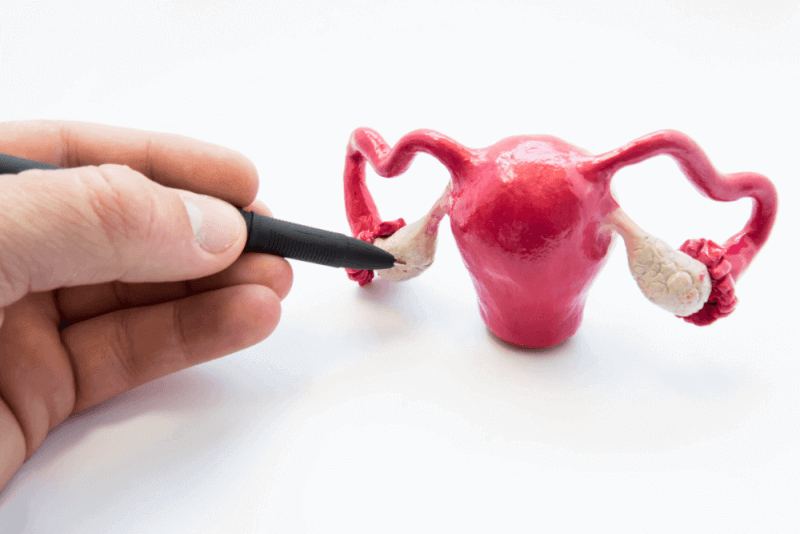What is Uterine Prolapse?
The uterus, the female reproductive organ, is also known as the uterus in medical language. In women who have given birth, the uterus, which is larger than in women who have not, can sag due to the weakening of the pelvic muscles and connective tissues over time. In this condition, called uterine prolapse, the uterus slides downwards and causes various complications.
Although uterine prolapse does not cause much discomfort in some cases, it can protrude from the vagina in advanced cases. At this stage, it causes serious discomfort to the patient.
Diagnosis Methods for Uterine Prolapse
Women suffering from uterine prolapse may consult a doctor with pain, pressure and a feeling of fullness. The specialist doctor who performs the pelvic examination evaluates the situation together with the patient's complaints.
Causes of Uterine Prolapse
Uterine prolapse, which is a factor that reduces the quality of daily life for female patients, can develop due to many reasons, especially vaginal delivery. These reasons are as follows:
- Advancing age
- Multiple pregnancy and multiple births
- Being overweight
- Vaginal delivery of large babies
- Use of vacuum during normal labor
- Chronic diseases that cause excessive coughing
- Frequent repeated straining in patients with chronic constipation
- Lifting heavy objects
- Genetic factors
- Estrogen deficiency in menopausal women
Symptoms of Uterine Prolapse
If the uterine prolapse is mild, it may not cause any symptoms. However, the symptoms seen in cases of progressive uterine prolapse are as follows:
- Pain in the groin
- Pain in the lower back
- Urinary incontinence
- Difficulty urinating
- Feeling pain during sexual intercourse
- Vaginal bleeding
- Vaginal discharge
- Bowel problems
- Tissues protruding from the vagina
- Feeling fullness in the vagina
Uterine Prolapse Treatment Methods
If the condition of uterine prolapse has not progressed, treatment is usually not applied. These patients are advised to eat a healthy diet, do kegel exercises and lose any excess weight. They are also advised to avoid heavy lifting and resolve any constipation.
However, for moderate and advanced uterine prolapse, there are treatment methods that vary depending on the patient's history and condition. Generally, uterine prolapse can be eliminated with a comfortable operation. However, for patients who do not accept surgery, silicone instruments called vaginal pessaries can be used. The pessary placed in the vagina supports the uterus and prevents it from hanging down. However, the use of pessaries is not used to correct sagging. It only helps to reduce the patient's complaints. The use of pessaries also requires great care. The pessary should be removed and cleaned at frequent intervals to prevent the risk of infection. Pesser is not a definitive solution for uterine prolapse.
Exercise for Uterine Prolapse
Kegel exercises are a set of exercises that help women strengthen their pelvic floor muscles. The problem of uterine prolapse can be prevented with regular kegel exercises.
For women who have not done kegel exercises before, it will first be necessary to find the pelvic floor muscle. When urinating in the toilet, the pelvic floor muscle is the muscle that suddenly stops the flow of urine. With this method, it is easy to learn how to control the pelvic floor muscle. Then, during the day, you can do a kegel exercise by holding the pelvic floor muscle for 5 seconds and releasing it. It is possible to extend the holding time over time, and this exercise can be done 3-4 times a day in sets of 10. It is important to empty the bladder before exercise.
Uterine Prolapse Surgery
The surgery option, which allows patients to definitively get rid of the complaint of uterine prolapse, is preferred depending on the patient's condition. The most appropriate surgical procedure is chosen according to the patient's age, whether she has given birth or not and the condition of the sagging. In addition to hysterectomy, which means complete removal of the uterus, there are also procedures that are performed only on the pelvic floor muscles. The types of uterine prolapse surgery are as follows:
-
Robotic Surgery
Minimally invasive surgery with the help of a robot is performed under general anesthesia. Robotic tools are inserted through a few minimally sized incisions in the patient's abdomen and simultaneously transmit images to the surgeon. The surgeon cuts the ligaments holding the uterus with robotic tools controlled by himself and allows it to come out of the vagina.
This method, which is preferred in cases of advanced uterine prolapse, is very comfortable. The minimal incisions do not cause any aesthetic problem for the patient. This method is generally suitable for women who are not planning to give birth and has a very low complication rate.
-
Open Surgery
Under general anesthesia and in an operation lasting about 3-4 hours, a large incision is made in the lower abdomen and the uterus is removed. The incision in the abdomen is then closed.
Open surgery, which causes a significant scar in the abdominal area, is also the operation with the longest recovery period. The risk of complications is higher in this method, which is preferred if the patient is not suitable for other surgical procedures.
-
Laparoscopic Surgery
With the help of surgical instruments that enter through several tiny incisions in the abdomen, the uterus is cut and removed from the vagina. In this procedure performed under general anesthesia, if there is an opening in the vagina, it is sutured. Incisions in the abdomen usually do not cause complications.
The difference of this procedure, which has a recovery rate as fast as robotic surgery, from robotic surgery is that the procedure is performed by the surgeon himself, not robots.
-
Pelvic Floor Surgery
In contrast to hysterectomy, pelvic floor surgery aims to strengthen weakened muscles. Under general anesthesia, an incision in the abdomen or an intervention through the vagina allows the connective tissues to become stronger.
This surgery is a method preferred by women who do not want to have their uterus removed or who want to give birth.
Things to Consider After Uterine Prolapse Surgery
There are rules to be followed to minimize the risk of infection and ensure a faster recovery after uterine prolapse surgery. Do not swim in the pool or sea for at least 1 month and avoid sexual intercourse. Public baths should also not be used during this period. Short showers should be preferred instead of baths. After the surgery, it is important to use the medications prescribed by the doctor regularly and to contact the doctor in case of bleeding or discharge. It is also necessary to eat carefully to avoid constipation and gas. Not lifting heavy objects for a few months after the surgery also speeds up the patient's recovery process.
Recovery Process After Uterine Prolapse Surgery
After the surgery, a rapid recovery process can be experienced by fully complying with the doctor's recommendations. Patients usually recover within a month and can return to their daily routine. However, staying away from environments that carry the risk of infection for the first few months allows the patient to recover faster.










